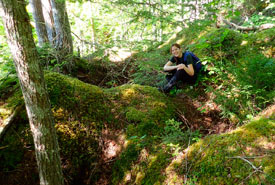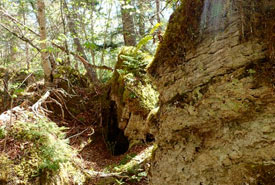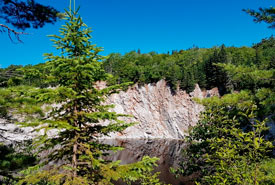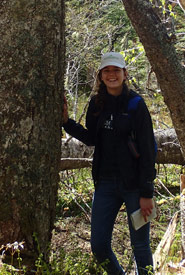Sinkholes, cliffs and ravines – oh my!

Amy exploring a section of karst forest in Cape Breton, NS (Photo by NCC)
As a conservation intern for the Nature Conservancy of Canada’s (NCC’s) Atlantic Region this summer, I’ve battled mosquitoes and deer flies, bushwhacked through rose bushes and hawthorns, almost lost a rubber boot in an open bog — and I’ve loved every single day of it!
Working for NCC has been an incredibly rewarding experience. Between meeting volunteers and community leaders, spending time in the office and in the field alongside knowledgeable and enthusiastic coworkers and constantly learning new things, I’ve had an amazing three months.
One of the most enjoyable aspects has been getting to explore NCC’s diverse protected areas across Nova Scotia.

Karst forest with exposed gypsum and open caverns (Photo by NCC)
Recently, I had the privilege of visiting Cape Breton, where NCC has started targeting conservation efforts in the province. Being from PEI, Canada’s smallest province, spending five days exploring rugged and beautiful locations around the highlands was a completely new experience for me and an amazing treat.
One of the many things that makes Cape Breton special is the gypsum — a type of rock that’s water soluble — which makes up the underlying rock (under the grass and soil) in certain areas. Over time, and with natural weathering, the gypsum dissolves to create stunning and incredibly unique (and often treacherous) landscapes of underground caverns and sinkholes. Known as “karst” topography, these forests host unique and valuable ecosystems, particularly the microclimates within the crevasses of the gypsum. Even in mid-July, snow can be found hiding in between the rocks! Because of the gypsum, the soil in Cape Breton has a very high pH value, whereas the rest of Nova Scotia soil tends to have a low pH value. This means that the karst forest can be home to many rare species that are not supported by other ecosystems in the province.
I spent two full days climbing around the karst forest at a property recently acquired by NCC. Equal parts exciting and nerve-racking, navigating the sinkholes takes a lot of thought and effort. It involves climbing on top of gypsum ridges — areas that have not been dissolved — and avoiding the frequent depressions, which signal unstable sinkholes. These sinkholes can vary from slight, moss-covered slopes in the ground to ravines 20 metres deep with exposed gypsum. There was also a mature forest growing on top of the karst, which meant that I had to climb around trees while also dodging the holes! It was all worth it in the end though.

The steep gypsum cliffs, lake and mature forest that served as a great view during lunch. (Photo by NCC)
Not many jobs allow you to spend your lunch break sitting in the sun beside a fluffy bed of moss, surrounded by huge hemlock trees, while overlooking massive gypsum cliffs and seemingly bottomless ponds. Throughout my week in Cape Breton, I found myself thinking how lucky I was to be able to explore these karst forests — stunning landscapes that were beyond anything I’d ever imagined.
Nova Scotia has more gypsum than any other place in North America. These karst habitats, however, have long been targeted and mined for the easy-to-access gypsum rock. It’s important for NCC to protect these beautiful and ecologically valuable areas from future threats. Getting to be a part of the work that NCC does to protect these and countless other unique ecosystems across the province has been an unforgettable experience.


